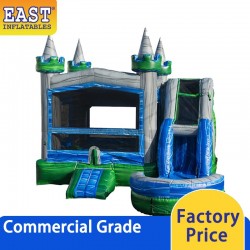
Inflatable castles offer a fun and engaging experience for children, but their convenience extends beyond just play. One of the key advantages of inflatable castles is how relatively simple it is to inflate and deflate them. This article explores the ease of these processes and what factors can influence them.
Inflating an Inflatable Castle
Inflating an inflatable castle is generally a straightforward process, thanks to modern technology and design:
- Air Blower: Most inflatable castles come with an electric air blower that makes the inflation process quick and easy. Simply connect the blower to the inflation tube, turn it on, and the castle will begin to expand.
- Setup Time: Depending on the size of the inflatable castle, the inflation process typically takes between 5 to 15 minutes. Larger units may take slightly longer, but the process is generally efficient.
- Guidelines: Following the manufacturer's instructions is crucial. Proper setup ensures that the inflatable castle is evenly inflated and maintains its shape and safety standards.
Deflating an Inflatable Castle
Deflating an inflatable castle is also relatively simple, though it may require a few additional steps:
- Deflation Valve: Inflatable castles are equipped with a deflation valve that allows air to escape quickly. Open the valve to start the deflation process, and the castle will gradually shrink.
- Manual Assistance: While the air blower can be used to help speed up deflation, some manual assistance is often needed. Gently pressing on the castle to expel air more efficiently can help expedite the process.
- Time Required: Deflation generally takes less time than inflation, typically ranging from 5 to 10 minutes. The speed may vary depending on the size of the castle and the efficiency of the deflation valve.
Factors Affecting Ease of Inflation and Deflation
Several factors can influence how easy it is to inflate and deflate an inflatable castle:
- Size: Larger inflatable castles may require more time and effort to inflate and deflate compared to smaller models. The size of the air blower used can also impact the speed of inflation.
- Material Quality: The type and quality of the material used in the inflatable castle can affect how easily it inflates and deflates. High-quality materials tend to be more flexible and easier to manage.
- Design: Features such as multiple compartments or complex designs can influence the ease of inflation and deflation. Simpler designs generally inflate and deflate more quickly.
Tips for Efficient Inflation and Deflation
To make the process as smooth as possible, consider these tips:
- Pre-Check Equipment: Ensure that the air blower and deflation valve are in good working condition before starting the process.
- Clear the Area: Make sure the area around the inflatable castle is clear of debris and obstacles to facilitate smooth inflation and deflation.
- Follow Instructions: Adhere to the manufacturer's guidelines for both inflation and deflation to ensure optimal performance and safety.
Conclusion
Inflating and deflating an inflatable castle is generally a straightforward process, thanks to modern air blowers and design improvements. With proper equipment and adherence to guidelines, the process can be efficient and hassle-free. Understanding the factors that affect inflation and deflation will help ensure that your inflatable castle is ready for fun in no time.



